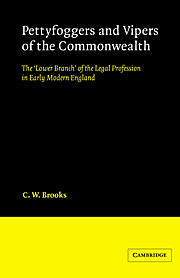 Pettyfoggers and Vipers of the Commonwealth
Pettyfoggers and Vipers of the Commonwealth Book contents
- Frontmatter
- Contents
- List of tables and figures
- Preface
- Abbreviations
- 1 Introduction
- 2 Lawyers and the royal courts in London during the reign of Elizabeth
- 3 The legal profession in the provinces
- 4 The increase in litigation
- 5 The causes of the increase in litigation
- 6 The increase in litigation and the legal profession
- 7 The attitudes of layman and attempts at reform
- 8 Clerkship, the inns of chancery, and legal education
- 9 Private practice
- 10 Public office and politics
- 11 Fees and incomes
- 12 Conclusion
- Appendix: Analysis of the social status of litigants in King's Bench and Common Pleas, 1560–1640
- Notes
- Select bibliography
- Index
- CAMBRIDGE STUDIES IN ENGLISH LEGAL HISTORY
10 - Public office and politics
Published online by Cambridge University Press: 28 October 2009
- Frontmatter
- Contents
- List of tables and figures
- Preface
- Abbreviations
- 1 Introduction
- 2 Lawyers and the royal courts in London during the reign of Elizabeth
- 3 The legal profession in the provinces
- 4 The increase in litigation
- 5 The causes of the increase in litigation
- 6 The increase in litigation and the legal profession
- 7 The attitudes of layman and attempts at reform
- 8 Clerkship, the inns of chancery, and legal education
- 9 Private practice
- 10 Public office and politics
- 11 Fees and incomes
- 12 Conclusion
- Appendix: Analysis of the social status of litigants in King's Bench and Common Pleas, 1560–1640
- Notes
- Select bibliography
- Index
- CAMBRIDGE STUDIES IN ENGLISH LEGAL HISTORY
Summary
The participation of well-known common laywers such as Sir Edward Coke, John Selden, Francis Bacon, and William Noy in some of the more important political debates of the early seventeenth century is a familiar feature of early Stuart history. In the case of these eminent barristers, it is usually possible to find out something about their political attitudes and activities either by looking at the speeches they made in parliament or by reading their published works. By comparison, the public careers of members of the lower branch are much more obscure. Very few of them sat in parliament, and, although some practitioners wrote books, the instances in which the thought and action of individuals can be analysed in conjunction are extremely rare. Consequently, a study of the political role of the lower branch must take us away from national politics to the county and the town, and any conclusions about the characteristic impact of this group of lawyers must perforce be drawn somewhat obliquely.
Even in the provinces, most practitioners lacked the wealth and social cachet necessary to lay claim to important positions such as a place on the commissions of the peace or the office of sheriff. But there were a number of local administrative offices which could provide a means of entry into public life. By the early seventeenth century, country attorneys frequently filled a long list of posts such as that of undersheriff, coroner, feodary for the court of Wards, clerk of the peace, clerk of assize, and, perhaps most frequently, town clerk.
- Type
- Chapter
- Information
- Pettyfoggers and Vipers of the CommonwealthThe 'Lower Branch' of the Legal Profession in Early Modern England, pp. 204 - 226Publisher: Cambridge University PressPrint publication year: 1986
